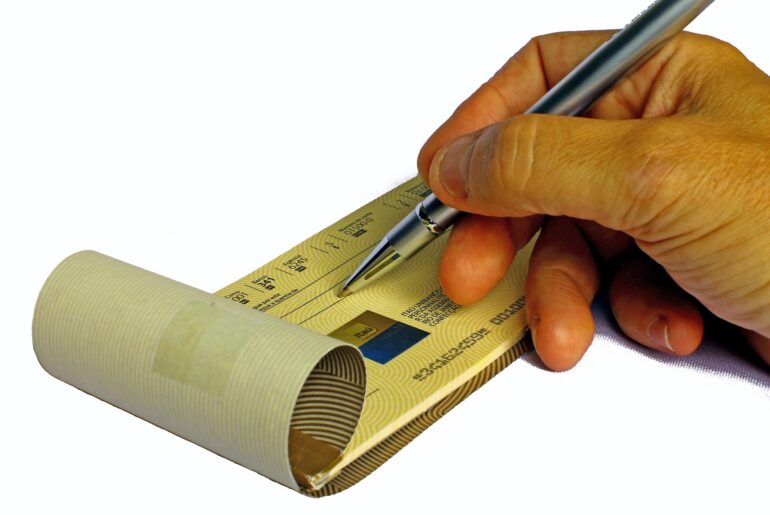This article may contain references to products or services from one or more of our advertisers or partners. We may receive compensation when you click on links to those products or services. Nonetheless, our opinions are our own.
Understanding the tools at your disposal can significantly improve your financial management. One of the most essential financial instruments is a checking account. If you’ve ever wondered, “What is a checking account?” or been unsure about its purpose and benefits, you’re in the right place. In this article, we’ll dive into the details of checking accounts, exploring how they work, their features, and why they’re an important component of your financial life. By the end, you’ll have a clear understanding of this vital banking tool and how it can help you manage your day-to-day expenses with ease. Let’s get started!
- Understanding the Basics of a Checking Account
- Key Features to Look for in a Checking Account
- Checking Account Insurance
- How to Choose the Right Bank for Your Needs
- Opening a Checking Account: A Step-by-Step Guide
- Managing Your Checking Account Effectively
- Understanding Overdrafts and How to Avoid Fees
- Avoiding Common Pitfalls with Checking Accounts
- Tips for Maximizing Your Checking Account Benefits
- Checking Accounts and Credit Scores
- Frequently Asked Questions
- Recommended Reads
Understanding the Basics of a Checking Account
A checking account is a fundamental tool for managing your daily finances. Think of it as your financial hub where you carry out your day-to-day transactions. It allows you to deposit your salary, pay bills, shop, and access your funds quickly when you need them most. One of the best things about checking accounts is their accessibility. You can use ATMs, write checks, or make online transfers, making it a versatile option for managing your cash flow.
When choosing a checking account, look for features that suit your lifestyle and financial habits. Consider the following:
- No Monthly Fees: Some accounts charge maintenance fees, but many banks offer options that waive these fees with a minimum balance or direct deposit.
- ATM Access: Check if your bank has a wide network of ATMs to avoid unnecessary fees when withdrawing cash.
- Overdraft Protection: This feature can help you avoid declined transactions or overdraft fees when you accidentally spend more than your balance.
- Online and Mobile Banking: Ensure that your bank provides user-friendly digital tools for easy access to your account information and transaction history.
By finding a checking account that aligns with your needs, you set yourself up for more efficient financial management and peace of mind.
Key Features to Look for in a Checking Account
When you’re on the hunt for the perfect checking account, there are several key features to keep in mind that can greatly enhance your banking experience. First and foremost, consider the fees associated with the account. Many banks offer no-fee checking accounts, which can save you money in the long run. Look for options that waive monthly maintenance fees if you maintain a minimum balance or set up direct deposits. Additionally, check for ATM access; having a broad network of ATMs can make it easier to access your funds without incurring extra charges.
Another crucial aspect to evaluate is the interest rate on your checking account. While many checking accounts don’t offer high interest, some banks may offer competitive rates that let your money grow a bit. Also, explore the features that facilitate online and mobile banking. The ability to manage your account through an app or website is essential in today’s fast-paced world. Ensure the platform is user-friendly and offers services like bill pay, mobile deposits, and account alerts.
Types of Checking Accounts
Types of Checking Accounts
1. Basic Checking Account: This type of account typically has low or no monthly fees but may have limited features. It’s best for those who prefer simplicity in their banking needs.
2. Interest-Bearing Checking Account: This account offers a small interest rate on the balance maintained in the account. It’s suitable for individuals who want their money to work for them, even in a checking account.
3. Student Checking Account: Geared towards students, these accounts often have low or no fees and may offer perks like overdraft protection or rewards for good grades.
Checking Account Insurance
It’s essential to understand the protection your funds have in a checking account. Most banks provide FDIC (Federal Deposit Insurance Corporation) coverage, which insures your deposits up to $250,000 per depositor, per insured bank, for each account ownership category. This insurance helps safeguard your money in case the bank faces financial troubles.
Furthermore, some banks offer additional security measures like fraud monitoring and zero liability protection for unauthorized transactions made with your debit card. It’s crucial to inquire about these features when choosing a bank for your checking account to ensure your funds are safe and secure.
How to Choose the Right Bank for Your Needs
When choosing a bank, think about what features matter most to you. Banks offer different types of accounts, services, and fees, so evaluating these options will help you find the best fit for your lifestyle and goals. Start by considering whether you need a bank with a wide range of services, like investment options and personal loans, or if a basic checking account will suffice. Reflect on how you tend to manage your money—are you a frequent traveler? You might prioritize a bank with a strong online platform and minimal foreign transaction fees.
Next, look into factors such as:
- Fees: Investigate monthly maintenance fees, ATM fees, and conditions for fee waivers.
- Account Access: Consider whether the bank has branches nearby or if you prefer online banking.
- Interest Rates: Compare how much interest you can earn on your checking account and any associated savings accounts.
- Customer Service: Read reviews to gauge the quality of support you’ll receive when you need assistance.
Conducting thorough research is crucial to select a financial partner who meets your needs. Additionally, if available, take advantage of tools and resources provided by banks, such as budgeting apps and financial education workshops, to help you on your financial journey.
Opening a Checking Account: A Step-by-Step Guide
Opening a checking account is a straightforward process that begins with choosing the right bank for your needs. Once you’ve found a suitable bank, follow these steps to open a checking account:
1. Gather Required Documents: Typically, you’ll need identification documents such as a driver’s license or passport, proof of address, and your social security number.
2. Visit the Bank: Schedule an appointment or visit your chosen bank in person to speak with a representative who can guide you through the account opening process.
3. After selecting a bank that aligns with your financial habits, the next step is to open a checking account tailored to your needs. Begin by assembling necessary documentation like your driver’s license, proof of address, and social security number. These details are essential for the account opening process.
Set up a meeting with a bank representative either through an appointment or by visiting the branch directly. This step allows you to discuss account options, fees, and any specific requirements related to your financial goals. Utilize this opportunity to inquire about online banking accessibility, branch locations, and customer service quality.
Managing Your Checking Account Effectively
Effectively managing your checking account requires a mix of discipline and awareness of your spending habits. Start by closely monitoring your transactions and regularly reviewing your bank statements, whether online or on paper, to ensure you are aware of all incoming and outgoing funds. Consider creating a simple budget that outlines your income and regular expenses to prevent overspending. Here are some strategies you might find helpful:
- Set Up Alerts: Most banks offer notifications for transactions, low balances, or even bill reminders. This can help you stay on top of your finances.
- Categorize Your Spending: Use apps or spreadsheets to track where your money goes each month. This will help you identify areas for potential savings.
- Limit ATM Withdrawals: Relying too heavily on cash can lead to overspending. Keep cash withdrawals minimal and use your card for most purchases.
Additionally, consider the benefits of maintaining a buffer in your checking account. This buffer can act as a financial cushion, protecting you against overdraft fees or unexpected expenses.
Being proactive with these strategies will empower you to manage your checking account wisely and lay the foundation for a more secure financial future.
Common Checking Account Services
Common checking account services provided by most banks include online banking accessibility, branch locations, and customer service quality. Utilizing online banking allows you to conveniently manage your account from anywhere, check your balance, transfer funds, and pay bills electronically. Branch locations provide in-person assistance for more complex transactions or inquiries. Customer service quality is crucial for resolving issues promptly and efficiently. Prioritize a bank that offers strong online banking features, convenient branch locations, and excellent customer service to support your financial goals effectively.
Understanding Overdrafts and How to Avoid Fees
An overdraft occurs when you spend more money than what is available in your checking account. Banks may charge hefty fees for these transactions, leading to additional financial strain.
To avoid overdraft fees, it is essential to keep track of your account balance regularly. Set up notifications for low balances or consider linking a savings account for overdraft protection.
Another option is to opt out of overdraft coverage, which means your transaction will be declined if there are insufficient funds in your account.
Avoiding Common Pitfalls with Checking Accounts
Navigating the world of checking accounts can sometimes feel overwhelming, especially with the myriad of options and features available. To keep your finances in check, it’s crucial to steer clear of a few common mistakes that many people unknowingly make. Here are some pitfalls you might encounter:
- Overdraft Fees : Keep a close eye on your balance. Falling below zero not only incurs hefty fees but also affects your credit score.
- Inefficient Use of ATM Networks : Using out-of-network ATMs can lead to additional fees. Familiarize yourself with your bank’s ATM locations to avoid unnecessary charges.
- Ignoring Account Statements : It’s easy to skip reviewing your monthly statements. Make it a habit to examine them for any unauthorized transactions or discrepancies.
- Neglecting to Compare Account Features : Not all checking accounts are created equal. Take time to compare service fees, interest rates, and features to find what best suits your needs.
Tips for Maximizing Your Checking Account Benefits
To truly take advantage of your checking account, start by understanding the various features it offers. Look for accounts that provide higher interest rates or rewards programs, as this can help your money work harder for you. Additionally, take advantage of online banking tools; most banks now offer apps that let you track your spending, set up alerts for low balances, and even pay bills directly from your phone. Staying in control of your finances has never been easier!
Don’t overlook the importance of maintaining a minimum balance if your account requires it; this can help you avoid monthly fees. Consider setting up automatic transfers to your savings account each month to cultivate a habit of saving without even thinking about it. To make the most of your checking account, also ensure you are aware of:
- ATM Access : Find out which ATMs are part of your network to avoid fees.
- Overdraft Protections : Understand your options and avoid costly charges.
- Monthly Statements : Regularly review them for accuracy and budgeting insights.
Checking Accounts and Credit Scores
While checking accounts may not directly impact your credit score, they can still play a crucial role in your overall financial health. Maintaining a positive relationship with your checking account by avoiding overdrafts, monitoring for fraudulent activity, and paying bills on time can demonstrate responsible money management to potential lenders.
By utilizing the features of your checking account effectively, such as setting up automatic transfers and taking advantage of online banking tools, you can create good financial habits that may indirectly benefit your credit score over time.
Frequently Asked Questions
What is a checking account?
A checking account is a type of bank account that allows you to deposit and withdraw money easily. It provides quick access to your funds for daily transactions, such as paying bills, making purchases, and withdrawing cash from ATMs.
How does a checking account work?
When you open a checking account, you can deposit money into it and use checks, debit cards, or electronic transfers to spend that money. You can also set up direct deposits for your paycheck or other income sources. Most checking accounts allow you to access your balance and transaction history online or through a mobile app.
What are the benefits of having a checking account?
Checking accounts offer several advantages, including ease of access to funds, a safe place to store your money, and the ability to quickly manage your finances. They often provide online banking features, allowing you to track your spending and pay bills conveniently.
Are there any fees associated with checking accounts?
Yes, many checking accounts come with fees, such as monthly maintenance fees or transaction fees. However, some banks offer fee-free accounts if you meet certain criteria, like maintaining a minimum balance or setting up direct deposits.
Can I earn interest on a checking account?
Some checking accounts do offer interest, but the rates are typically lower than those offered on savings accounts. Interest-bearing checking accounts may require you to maintain a minimum balance to earn interest.
How do I choose the right checking account for me?
When choosing a checking account, consider factors such as fees, features, interest rates, and convenience. It’s important to compare different banks and their offerings to find an account that aligns with your financial needs and spending habits.

Reviewed and edited by Albert Fang.
See a typo or want to suggest an edit/revision to the content? Use the contact us form to provide feedback.
At FangWallet, we value editorial integrity and open collaboration in curating quality content for readers to enjoy. Much appreciated for the assist.
Did you like our article and find it insightful? We encourage sharing the article link with family and friends to benefit as well - better yet, sharing on social media. Thank you for the support! 🍉
Article Title: Exploring the Basics: What Is a Checking Account
https://fangwallet.com/2025/02/07/what-is-a-checking-account/The FangWallet Promise
FangWallet is an editorially independent resource - founded on breaking down challenging financial concepts for anyone to understand since 2014. While we adhere to editorial integrity, note that this post may contain references to products from our partners.
The FangWallet promise is always to have your best interest in mind and be transparent and honest about the financial picture.
Become an Insider

Subscribe to get a free daily budget planner printable to help get your money on track!
Make passive money the right way. No spam.
Editorial Disclaimer: The editorial content on this page is not provided by any of the companies mentioned. The opinions expressed here are the author's alone.
The content of this website is for informational purposes only and does not represent investment advice, or an offer or solicitation to buy or sell any security, investment, or product. Investors are encouraged to do their own due diligence, and, if necessary, consult professional advising before making any investment decisions. Investing involves a high degree of risk, and financial losses may occur including the potential loss of principal.
Source Citation References:
+ Inspo












































